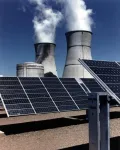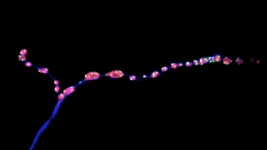Machine learning models to help photovoltaic systems find their place in the sun
Scientists develop algorithms that predict the output of solar cells, easing their integration into existing power grids
2021-07-20
(Press-News.org) With the looming threat of climate change, it is high time we embrace renewable energy sources on a larger scale. Photovoltaic systems, which generate electricity from the nearly limitless supply of sunlight energy, are one of the most promising ways of generating clean energy. However, integrating photovoltaic systems into existing power grids is not a straightforward process. Because the power output of photovoltaic systems depends heavily on environmental conditions, power plant and grid managers need estimations of how much power will be injected by photovoltaic systems so as to plan optimal generation and maintenance schedules, among other important operational aspects.
In line with modern trends, if something needs predicting, you can safely bet that artificial intelligence will make an appearance. To date, there are many algorithms that can estimate the power produced by photovoltaic systems several hours ahead by learning from previous data and analyzing current variables. One of them, called adaptive neuro-fuzzy inference system (ANFIS), has been widely applied for forecasting the performance of complex renewable energy systems. Since its inception, many researchers have combined ANFIS with a variety of machine learning algorithms to improve its performance even further.
In a recent study published in Renewable and Sustainable Energy Reviews, a research team led by Jong Wan Hu from Incheon National University, Korea, developed two new ANFIS-based models to better estimate the power generated by photovoltaic systems ahead of time by up to a full day. These two models are 'hybrid algorithms' because they combine the traditional ANFIS approach with two different particle swarm optimization methods, which are powerful and computationally efficient strategies for finding optimal solutions to optimization problems.
To assess the performance of their models, the team compared them with other ANFIS-based hybrid algorithms. They tested the predictive abilities of each model using real data from an actual photovoltaic system deployed in Italy in a previous study. The results, as Dr. Hu remarks, were very promising: "One of the two models we developed outperformed all the hybrid models tested, and hence showed great potential for predicting the photovoltaic power of solar systems at both short- and long-time horizons."
The findings of this study could have immediate implications in the field of photovoltaic systems from software and production perspectives. "In terms of software, our models can be turned into applications that accurately estimate photovoltaic system values, leading to enhanced performance and grid operation. In terms of production, our methods can translate into a direct increase in photovoltaic power by helping select variables that can be used in the photovoltaic system's design," explains Dr. Hu. Let us hope this work helps us in the transition to sustainable energy sources!
INFORMATION:
Reference
Authors: Mosbeh R. Kaloop (1,2,3), Abidhan Bardhan (4), Navid Kardani (5), Pijush Samui (4), Jong Wan Hu (1,2), Ahmed Ramzy (6)
Title of original paper: Novel application of adaptive swarm intelligence techniques coupled with adaptive network-based fuzzy inference system in predicting photovoltaic power
Journal: Renewable and Sustainable Energy Reviews
DOI: https://doi.org/10.1016/j.rser.2021.111315
Affiliations:
(1) Department of Civil and Environmental Engineering, Incheon National University
(2) Incheon Disaster Prevention Research Center, Incheon National University
(3) Public Works and Civil Engineering Department, Mansoura University
(4) Department of Civil Engineering, National Institute of Technology Patna
(5) Civil and Infrastructure Engineering Discipline, School of Engineering, RMIT
(6) Mechanical Power Engineering Department, Mansoura University
About Incheon National University
Incheon National University (INU) is a comprehensive, student-focused university. It was founded in 1979 and given university status in 1988. One of the largest universities in South Korea, it houses nearly 14,000 students and 500 faculty members. In 2010, INU merged with Incheon City College to expand capacity and open more curricula. With its commitment to academic excellence and an unrelenting devotion to innovative research, INU offers its students real-world internship experiences. INU not only focuses on studying and learning but also strives to provide a supportive environment for students to follow their passion, grow, and, as their slogan says, be INspired.
Website: http://www.inu.ac.kr/mbshome/mbs/inuengl/index.html
About the author
Professor Jong Wan Hu received his doctorate from the School of Civil and Environmental Engineering at Georgia Institute of Technology. He served as Post-Doctorate Research Fellow at the Structural, Mechanics, and Material Research Group in Georgia Institute of Technology, Associate Research Fellow at the Korea Institute of S&T Evaluation and Planning (KISTEP), and as Assistant Administrator at the National S&T Council (NSTC). He is currently a Professor at Incheon National University, Korea. He has been an active member of ASME and ASCE. His research interests include computational solid mechanics, composite materials, and plasticity modeling.
[Attachments] See images for this press release:

ELSE PRESS RELEASES FROM THIS DATE:
2021-07-20
Researchers in the BOTTLE Consortium, including from the U.S. Department of Energy's (DOE's) National Renewable Energy Laboratory (NREL) and the University of Portsmouth, have identified using enzymes as a more sustainable approach for recycling polyethylene terephthalate (PET), a common plastic in single-use beverage bottles, clothing, and food packaging that are becoming increasingly relevant in addressing the environmental challenge of plastic pollution. An analysis shows enzyme-recycled PET has potential improvement over conventional, fossil-based methods of PET production across a broad spectrum of energy, carbon, and socioeconomic impacts.
The concept, if further developed and implemented at scale, could lead to ...
2021-07-20
Neurons communicate through rapid electrical signals that regulate the release of neurotransmitters, the brain's chemical messengers. Once transmitted across a neuron, electrical signals cause the juncture with another neuron, known as a synapse, to release droplets filled with neurotransmitters that pass the information on to the next neuron. This type of neuron-to-neuron communication is known as evoked neurotransmission.
However, some neurotransmitter-packed droplets are released at the synapse even in the absence of electrical impulses. These miniature release events -- or ...
2021-07-20
Every spring, the Daylight Saving Time shift robs people of an hour of sleep - and a new study shows that DNA plays a role in how much the "spring forward" time change affects individuals.
People whose genetic profile makes them more likely to be "early birds" the rest of the year can adjust to the time change in a few days, the study shows. But those who tend to be "night owls" could take more than a week to get back on track with sleep schedule, according to new data published in Scientific Reports by a team from the University of Michigan.
The study uses data from continuous sleep tracking ...
2021-07-20
Forensics specialists can use a commercial assay targeting mitochondrial DNA to accurately discriminate between wolf, coyote and dog species, according to a new study from North Carolina State University. The genetic information can be obtained from smaller or more degraded samples, and could aid authorities in prosecuting hunting jurisdiction violations and preserving protected species.
In the U.S., certain wolf subspecies or species are endangered and restricted in terms of hunting status. It is also illegal to deliberately breed wolves or coyotes with domesticated dogs.
"If ...
2021-07-20
EAST LANSING, Mich. - Diagnosing a rare medical condition is difficult. Identifying a treatment for it can take years of trial and error. In a serendipitous intersection of research expertise, an ill patient in this case a child and innovative technology, Bachmann-Bupp Syndrome has gone from a list of symptoms to a successful treatment in just 16 months.
The paper chronicling this lightning-fast scientific response to the Bachmann-Bupp Syndrome was published in the open-access journal, eLife.
For more than 25 years, André Bachmann, professor of pediatrics in Michigan State University College ...
2021-07-20
New research adds to a body of evidence indicating decisions about withdrawing life-sustaining treatment for patients with moderate-to-severe traumatic brain injury (TBI) should not be made in the early days following injury.
In a July 6, 2021, study published in JAMA Neurology, researchers led by UC San Francisco, Medical College of Wisconsin and Spaulding Rehabilitation Hospital followed 484 patients with moderate-to-severe TBI. They found that among the patients in a vegetative state, 1 in 4 "regained orientation" - meaning they knew who they were, their ...
2021-07-20
By Luciana Constantino | Agência FAPESP – A pregnant woman infected by zika virus does not face a greater risk of giving birth to a baby with microcephaly if she has previously been exposed to dengue virus, according to a Brazilian study that compared data for pregnant women in Rio de Janeiro and Manaus.
A zika epidemic broke out in Brazil in 2015-16 in areas where dengue is endemic. Both viruses are transmitted by the mosquito Aedes aegypti. Some of the states affected by the zika epidemic reported a rise in cases of microcephaly, a rare neurological disorder in which the baby’s brain fails to develop completely. Others saw no such rise.
According to this new study by Brazilian researchers, two factors explain the rise in microcephaly in only some areas: the ...
2021-07-20
When it comes to improving access to mental health services for children and families in low-income communities, a University of Houston researcher found having a warm handoff, which is a transfer of care between a primary care physician and mental health provider, will help build trust with the patient and lead to successful outcomes.
"Underserved populations face certain obstacles such as shortage of providers, family beliefs that cause stigma around mental health care, language barriers, lack of transportation and lack of insurance. A warm handoff, someone who serves as a go-between for experts and patients, can ensure connections are made," said Quenette L. Walton, assistant professor at the ...
2021-07-20
Irvine, CA - July 20, 2021 - In a new University of California, Irvine-led study, researchers found that a certain protein prevented regulatory T cells (Tregs) from effectively doing their job in controlling the damaging effects of inflammation in a model of multiple sclerosis (MS), a devastating autoimmune disease of the nervous system.
Published this month in Science Advances, the new study illuminates the important role of Piezo1, a specialized protein called an ion channel, in immunity and T cell function related to autoimmune neuroinflammatory disorders.
"We found that Piezo1 selectively restrains Treg cells, limiting their potential to mitigate ...
2021-07-20
Newborns at risk for Type 1 diabetes because they were given antibiotics may have their gut microorganisms restored with a maternal fecal transplant, according to a Rutgers study.
The study, which involved genetic analysis of mice, appears in the journal Cell Host & Microbe.
The findings suggest that newborns at risk for Type 1 diabetes because their microbiome - the trillions of beneficial microorganisms in and on our bodies - were disturbed can have the condition reversed by transplanting fecal microbiota from their mother into their gastrointestinal tract after the antibiotic course has been completed.
Type 1 diabetes is the most ...
LAST 30 PRESS RELEASES:
[Press-News.org] Machine learning models to help photovoltaic systems find their place in the sun
Scientists develop algorithms that predict the output of solar cells, easing their integration into existing power grids




